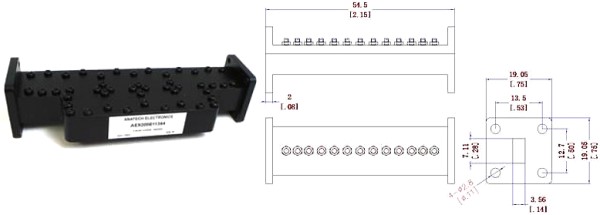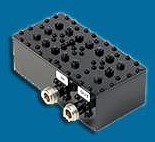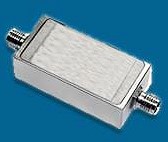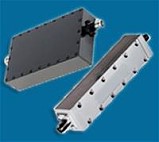
Press Release Archives:
2025 |
2024 |
2023 |
2022 |
2021
2020 |
2019
Content is copyright of company represented. Page format, custom text and
images are RF Cafe copyright - do not distribute. Note: Beginning
March 2025, posting of press releases will cost $100 each for non-advertisers.

Sam Benzacar of Anatech Electronics, an RF and microwave filter company, has
published his September newsletter that features his short op-ed entitled
"Interference: 5G Hits a Snag." He mentions the unavoidable issues that are being
faced by telcos trying to deploy their 5G infrastructure that operates in the millimeter-wave
bands. The two most notable difficulties are that of expensive equipment costs and
relatively short propagation distances (per
Mr. Friis' equation).
It is the latter that is partly responsible for the former difficulty because shorter
ranges translate to needing more closely spaced cells. Re-allocation of some existing
bands is inevitable, which worries Hams more than just a little since their spectrum
privileges seem to uninformed bureaucrats to be the low fruit for easy picking.
In other news, Sam includes other news related to our RF industry.
A Word from Sam Benzacar
 Interference:
5G Hits a Snag
By Sam Benzacar
In previous newsletters, I've written about what I believe will be an exponential
increase in interference within the low- and mid-band spectrum between UHF and 6
GHz in the coming years, as more services operate there. But now the proof is beginning
to reveal itself, and we should know: We've been mitigating interference with RF
and microwave filter solutions for nearly three decades, and we're seeing more requests
recently for filters and filter-based products in the "sub-GHz" region than before.
While this probably seems obvious considering these frequencies are already near
saturation, but there's more to it than that. It's getting worse because of the
FCC's drive to find more spectrum to for 5G that it needs to accommodate its very
high data rates and bandwidth-hungry applications. This is supposed to be taken
care of by using millimeter wavelengths where several gigahertz of spectrum is available,
but here's the rub: The costs for deploying 5G at these frequencies will be immense,
infrastructure will take many years to fully deploy, and it may not work out all
that well even then, owing to its problematic propagation characteristics. So, the
FCC and wireless industry are investigating how to get more from spectrum below
6 GHz.
What's interesting about this, aside from greater interference potential, is
that the U.S. appears to be the only country that hasn't already assumed that (a)
relying on millimeter-wave frequencies alone won't solve the problem and (b) the
"Race to 5G" will be only won by relying instead on frequencies better suited for
the task. There are obviously lots of very smart people who know this but they're
being drowned by the marketing hype about the millimeter-wave camp.
Wireless carriers are already optimizing spectral efficiency and frequency reuse
using higher-order modulation schemes, MIMO, and other techniques. This leaves two
other possibilities for squeezing more from the sub 6 GHz spectrum: refarming existing
services to other bands (somewhere) and using frequency-sharing technology like
what's about to be used in the 600 MHz band, at 3.5 GHz for the Citizens Broadband
Radio Service (CBRS), and possibly at C-band (3.7 to 4.2 GHz) that's been used for
40 years by satellite operators to downstream television content to cable head-ends.
None of these approaches can entirely ensure that interference won't appear when
multiple services use the same frequencies, 5G is inserted between existing services,
or after existing services are booted from their current homes. In each of these
scenarios, interference is one of the top issues raised during the FCC rulemaking
process. This doesn't include a proposal by the Wi-Fi Alliance to expand this service
into the 5.925 to 7.125 GHz band, and other possibilities being pursued by the FCC.
All the above are being examined at a rapid pace as the clock is ticking on 5G
as the President has decided that the U.S. must lead the world in 5G deployment.
Stay tuned for updates.
Mid-Band Show Promise for High-speed 5G
 The U.S. remains the 5G speed leader with current
roll-outs achieving up to 1.8 Gb/s downstream data rates, but other countries are
notching up very high data rates as well—and unlike the U.S., they're not using
millimeter-wave spectrum to achieve it, according to Opensignal. That is, the mid-band
spectrum (below 6 GHz) is demonstrating its ability to support data rates near those
of the U.S. without resorting to the use of spectrum at much higher frequencies.
It's also the most popular region globally for 5G deployment, as it is much less
expensive to deploy as propagation distances are longer, requiring less equipment. The U.S. remains the 5G speed leader with current
roll-outs achieving up to 1.8 Gb/s downstream data rates, but other countries are
notching up very high data rates as well—and unlike the U.S., they're not using
millimeter-wave spectrum to achieve it, according to Opensignal. That is, the mid-band
spectrum (below 6 GHz) is demonstrating its ability to support data rates near those
of the U.S. without resorting to the use of spectrum at much higher frequencies.
It's also the most popular region globally for 5G deployment, as it is much less
expensive to deploy as propagation distances are longer, requiring less equipment.
 iPhones Come up Short in Download Speeds: Report iPhones Come up Short in Download Speeds: Report
High-end smartphones from OnePlus, LG, and Samsung have the fastest download
speeds in the U.S., according to a recent comparison of various phones. The OnePlus
7 Pro, LG V35, LG G8, and Samsung S10 and S10+ models tied for first place with
average 4G download speeds above 36 Mb/s. iPhone XS and XS Max users got 4G download
speeds over 25 Mb/s, while iPhone 7 and 6s users experienced much lower download
speeds of between 16.7 and 18.3 Mb/s. All but one smartphone model in Opensignal's
top 10 used chipsets and modems from Qualcomm.
 FCC Doppler
Radar FCC Doppler
Radar
The FCC's Enforcement Bureau has proposed fines and issued a formal industry
warning concerning devices that allegedly caused interference to the FAA's terminal
Doppler weather radar station in San Juan, Puerto Rico. The bureau proposed three
$25,000 fines against wireless internet service providers Boom Solutions, Integra
Wireless, and WinPR. This comes after news that millimeter-wave frequencies to be
used for 5G may reduce the ability of NOAA (and thus the Department of Defense as
well) to measure moisture levels from space.
 UK Military Developing Its Own Smallsats UK Military Developing Its Own Smallsats
The UK is planning to use a cluster of military radar satellites designed in
collaboration with Airbus in Project Oberon. A network of small spacecraft will
be able to visualize the Earth's surface in all weather conditions and at night
with very high resolution. The satellites would also have sensors to locate the
use of radio transmissions. The UK currently does not have its own Earth observation
system, relying instead on commercial imagery. The new satellites would use carbon-fiber
antennas designed by Oxford Space Systems that stow away for launch but spring into
shape once in orbit, using a "wrapped rib" structure.
Getting Ready for 5G:
Anatech Electronics introduce New Ka band 30.5 GHz Waveguide Band Pass Filter.
Featuring a center frequency of 30.5 GHz, a bandwidth of 1000 MHz, an Insertion
Loss 1 dB Max, and a Power Handling is 20 watts.

Anatech Electronics Introduces a New Line of Suspended Stripline and
Waveguide Type RF Filters
Check out Our Filter Products



Cavity Band Pass Filters
LC Band Pass Filters Cavity Bandstop/Notch Filter
About Anatech Electronics
Anatech Electronics, Inc. (AEI) specializes in the design and manufacture of
standard and custom RF and microwave filters and other passive components and subsystems
employed in commercial, industrial, and aerospace and applications. Products are
available from an operating frequency range of 10 kHz to 30 GHz and include cavity,
ceramic, crystal, LC, and surface acoustic wave (SAW), as well as power combiners/dividers,
duplexers and diplexers, directional couplers, terminations, attenuators, circulators,
EMI filters, and lightning arrestors. The company's custom products and capabilities
are available at www.anatechelectronics.com.
Contact:
Anatech Electronics, Inc. 70 Outwater Lane Garfield, NJ 07026 (973)
772-4242
sales@anatechelectronics.com
Posted September 17, 2019
|










 The U.S. remains the 5G speed leader with current
roll-outs achieving up to 1.8 Gb/s downstream data rates, but other countries are
notching up very high data rates as well—and unlike the U.S., they're not using
millimeter-wave spectrum to achieve it, according to Opensignal. That is, the mid-band
spectrum (below 6 GHz) is demonstrating its ability to support data rates near those
of the U.S. without resorting to the use of spectrum at much higher frequencies.
It's also the most popular region globally for 5G deployment, as it is much less
expensive to deploy as propagation distances are longer, requiring less equipment.
The U.S. remains the 5G speed leader with current
roll-outs achieving up to 1.8 Gb/s downstream data rates, but other countries are
notching up very high data rates as well—and unlike the U.S., they're not using
millimeter-wave spectrum to achieve it, according to Opensignal. That is, the mid-band
spectrum (below 6 GHz) is demonstrating its ability to support data rates near those
of the U.S. without resorting to the use of spectrum at much higher frequencies.
It's also the most popular region globally for 5G deployment, as it is much less
expensive to deploy as propagation distances are longer, requiring less equipment.
 iPhones Come up Short in Download Speeds: Report
iPhones Come up Short in Download Speeds: Report
 FCC Doppler
Radar
FCC Doppler
Radar UK Military Developing Its Own Smallsats
UK Military Developing Its Own Smallsats






